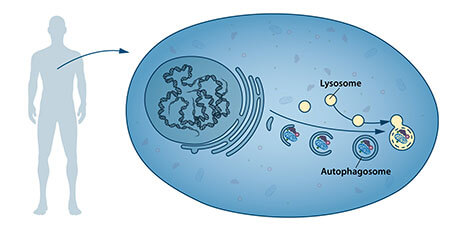This is a preliminary step to the breaking down of proteins by ubiquitin, a discovery for which the Israeli researchers Avraham Hershko and Aharon Chachanover were awarded the Nobel Prize in Chemistry in 2004 * Yoshinori Osumi deciphered the process that causes substances that are not needed in the cell, sometimes darkening different organelles, to be packaged for their breakdown. This process is important mainly in stress conditions such as hunger or disease

The winner of the 2016 Nobel Prize in Medicine and Physiology discovered and explained the operation of autophagy mechanisms, a basic component in the process of breaking down and recycling cellular components.
Autophagy is a word that combines two Greek words AUTO - which means self and phagein which means "to eat". Therefore, the meaning of the name autophagy is "self-eating". This concept developed during the sixties of the twentieth century. When it was first discovered that the cell could destroy its contents by enveloping it in a membrane and forming a sac-like vesicle and this is transported to the lysosome for degradation.
However, the process of decomposition and recycling remained largely a mystery until, in a series of experiments in the early nineties, 2016 Nobel Laureate in Medicine Yoshinori Osumi was able to identify the genes essential for autophagy in baker's yeast. He studied the mechanisms in yeast and also showed that similar sophisticated mechanisms are also used in our cells.
Oshumi's discoveries led to new insights about the fundamental importance of autophagy in many physiological processes such as the cells' coping with hunger or in response to infections. Mutations in autophagy genes can cause diseases and autophagic processes are involved in several diseases including cancer and neurological diseases.
Decomposition - a central role in all living cells
In the 1974s, an organelle inside the cell containing enzymes that digest proteins, carbohydrates and fats was observed for the first time. This organelle known as a lysosome functions as a workstation for the destruction of cell components. Belgian scientist Christian de Doube won the Nobel Prize in Physiology or Medicine in 1960 for the discovery of the lysosome. New observations during the XNUMXs showed that large amounts of cell materials and even whole organelles could sometimes be found inside the lysosome, so it was clear that there must be a strategy for transferring such a large cargo to the lysosome. De Dub was also the one who conducted a microscopic biochemical analysis and discovered a new type of vesicles transporting cargo to the degradation lysosome. He also coined the term autophagy to describe this process. The new vesicle was called autophagosomes.
In the 2004s and XNUMXs, another system for breaking down proteins, the proteasome, was discovered by Prof. Avraham Hershko, Prof. Aharon Chachanover and Prof. Irwin Rose. The three won the Nobel Prize in Chemistry for this discovery in XNUMX for the discovery of the process of breaking down substances in the cell by ubiquitin. The proteasome efficiently breaks down the proteins one by one
But this mechanism did not explain how the cell gets rid of large protein complexes and worn organelles. Could the process of autophagy be the answer? And if so, what are the mechanisms behind it.
A groundbreaking experiment
Yoshinori Ohsumi was active in various fields of research, but with the opening of his laboratory in 1988, he concentrated his efforts in the field of breaking down proteins in the vacuolar organelle - the organelle that leads to the lysosome in human cells. Yeast cells are relatively easy to study and as a result they are often used as a model for human cells. They are particularly useful in identifying genes involved in complex cellular pathways.
However, Ohsumi faced a big challenge - the yeast cells are small and it is difficult to separate their internal structures under the microscope. He wasn't even sure that the autophagy process existed in this creature. Oshumi explained that if he could disrupt the degradation process inside the tube, while the autophagy process is active, then the autophagosomes would have to accumulate inside the tube and be visible under the microscope.
He grew a yeast culture that had a mutation that caused it to lack enzymes for cell degradation and at the same time stimulated the autophagy process by starving the cell.
Within a few hours the vial was filled and the materials did not decompose. Ohsumi demonstrated that the autophagy process exists in yeast, but more importantly, he discovered a method for identifying and characterizing key genes involved in this process. This was the breakthrough he published in 1992 and brought him the Nobel Prize for 2016.

4 תגובות
Is there a connection between this important scientist and the controversial diet method called "autophagy"?
I ask because I attended a lecture in which the lecturer announced, more or less, that the expert who developed the diet method won the Nobel Prize.
Please with me.
Thank you very much, my father, for (another) serious and quick article that nicely makes the important developments in science accessible to the general public.
Interesting article - thanks. But proofreading won't hurt, I ran into four typos, so there's probably more than that.